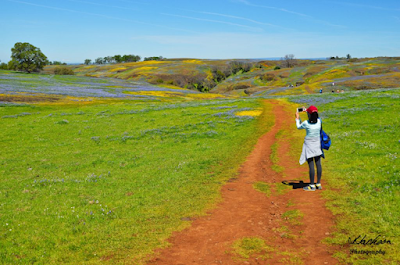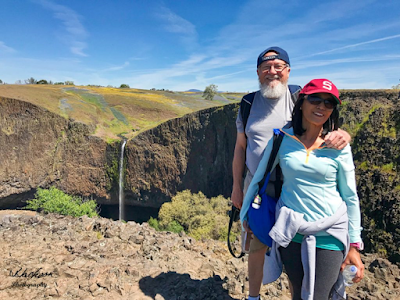Spectacular Wildflower Explosion at North Table Mountain Ecological Reserve
The 3,300-acre
North Table Mountain Ecological Reserve was created by prehistoric lava flows.
As the lava cooled it turned to basalt forming a mesa which offers an elevated
view of lava outcropping, vernal pools, and spectacular rainy season
waterfalls. But the main attraction is the rainbow explosion of spectacular
spring wildflowers.
As the winter
months turn to the warmer months of spring, Mother Nature produces a display of
the most colorful and spectacular wildflower show on earth. When the
wildflowers bloom by the millions, they draw many visitors from all over to
gaze in wonderment at the magnificent blossom colorations.
Waves of flowers
The North Table
Mountain Ecological Reserve is open year-round dawn to dusk. It is
located in Butte County, approximately 7 miles north of the town of Oroville.
Directions: From Hwy 70 in Oroville. Exit at Grand Ave (Exit 48). Go East
(right) on Grand Ave for 1 mile. Left on Table Mountain Blvd for a tenth of a
mile. Right on Cherokee Road 6.3 miles north to the reserve. Official access is
through a small parking lot on the west side of Cherokee Road.
Although during
the wildflower blooming season, photography is the number one activity in the
park. However, hiking and wildlife viewing are also major activities in
this vast park.
Streaks of color
Lupines grow in
abundance here. But there are many, many other varieties of wildflowers
that compete for space.
Road of color
An easy to hike
trail leads you from the park entrance to the majestic Phantom Falls.
Along the way your eyes will dark from one spectacular wildflower patch to
another.
A cairn stands sentry over a vast field of colorful
blooming wildflowers.
For more
information the North Table Mountain Ecological Reserve, call the North Central
Region Rancho Cordova office at (916) 358-2900
Fields of color
It was as though
Mary Poppins and her friends were taking a stroll, umbrellas in hand, as they
viewed the magical world of Mother Nature in full bloom.
Mesmerizing color
The gentle
swaying of brightly colored wildflowers in the soft breeze are hypnotic.
A CDFW Lands Pass
must be in possession by each visitor who is 16 years of age or older, however,
visitors who are in possession of a valid California hunting or fishing license
in their name are exempt from this requirement. Lands passes may be purchased
on-line, by phone at (800) 565-1458, or in-person at locations wherever hunting
and fishing licenses are sold.
Splashes of color
There are so many
spectacular colors that it makes you feel as though you are looking at many
artists brushes that were put away while still wet.
School and
organized youth groups, including accompanying adults, are exempt from the
lands pass requirement, but should contact the area to schedule a field trip at
least two weeks in advance.
The hills are alive with color!
Mother Nature
produces a riot of color, especially after a wet California winter. You
have to resist the temptation to run into the colorful meadows, Julie Andrews
style in the Sound of Music.
Sturdy closed-toe
footwear and water bottles are advised when visiting the area. Water, trash
receptacles, and restrooms are not available on site so plan ahead. Take
out what you bring in and if someone forgot their manners and left trash, pack
it out for them. It is prohibited to remove, collect, or disturb any
natural resources, whether it be wildflowers or other plants, rocks or
minerals, and animals. Dogs must be on a leash and please be a
responsible dog owner and pick up after your dog!
Dabs of color
Everywhere that
you look, you will see dabs of vibrant colors. Be sure to look for deer,
quail, frogs, wild turkey, and other birds in the park.
Strokes of color
In one area you
find an abundance of one colorful species of wildflowers, and in another you
might see a another, different and more colorful species. Make sure that
the battery in your camera is fully charged.
River of colors!
As you hike the road
to the Phantom Falls, you feel as though you are flowing in a river current
made up of wildly colored flowers.
The property
where the massive display of wildflowers is located was acquired by the
California Department of Fish and Wildlife in 1993 to preserve the Northern
Basalt Flow Vernal Pools habitat type and sensitive species. Funds for this
acquisition were provided by Proposition 70, a 1988 voter-approved initiative
that designated funds specifically for the acquisition of Significant Natural
Areas as identified by the Department.
Additional land
was acquired in 1997 to enable direct public access from the gravel parking lot
on Cherokee Road. The property was designated as an ecological reserve by the
Fish and Game Commission in 2003.
Color as far as
the eye can see awaits the visitor to the park. Give yourself ample time
to enjoy this gift from Mother Nature. Trees in the ravine habitats
include native oaks, madrones, California buckeyes, and California bays.
The birds that can be seen in the park include the golden eagle, turkey
vulture, peregrine falcon, canyon and rock wrens, and meadowlark.
The trail to
Phantom Falls is not difficult to trek. There are many side trails but
resist the urge to get off the main trail. And for goodness sake, don’t
trample the wildflowers just to get a selfie. There are plenty of places
for that and you don’t have to damage the natural display.
Phantom Falls is
also known as Coal Canyon Falls and is 164 feet (50 m) high, running off the
edge of Coal Canyon, in front of a massive basalt grotto. At the bottom of the
falls is a small pool that is home to a California newt subspecies, the Coastal
Range newt. As a seasonal waterfall, Phantom Falls runs only during the
rainy months, late autumn to early spring. It is named Phantom Falls because it
disappears during the dry season.
The massive
basalt wall was formed eons ago when lava flows hardened. You may notice
the individuals near the top rim. Hiking there is not forbidden but do exercise
caution as the ground can be slippery in wet seasons.
The king of the
Phantom Falls, a Rock Wren, lets the world know that this is his domain.
A painted lady
butterfly takes a brief moment of rest before gorging on the ample supply of
pollen.
The trail to the
waterfall is somewhat unimproved and the parking lot on Cherokee Road provides
access for hikers. It is about 2 miles (3.2 km) from the parking lot to the
waterfall, which is visible from the rim of Coal Canyon. Once there you
can a somewhat strenuous hike down to the base of the falls and back up. The
falls can also be reached from Coal Canyon Road at the bottom of Coal Canyon, a
hike of about the same distance but longer and more strenuous, over rocky
terrain.
Where the water
ends in thi8s photo, the steep waterfall begins. It is slippery up there so be careful!
The top of the Phantom Falls
Just below the
Phantom Falls there is a grotto that contains the shaft of an abandoned gold
mine dating back to the California Gold Rush. Today, there is no gold there,
but research still takes place in the mineshaft. Entering the mineshaft is
difficult but not prohibited.
The source of the
Phantom Falls is the creek shown above. The rainy season was good in
2018/2019 hence the abundance of colorful wildflowers. As the season
turns to late spring, the creek dries, and the waterfall disappears.
Reach for the sky!
As the watershed
at North Table Mountain Ecological Reserve dries, wildflowers compete in their
race to the sky where insects can easily find their pollen.
There are several sensitive plant and animal species that
occur on the preserve, they include:
• Limnanthes floccosa ssp. californica — Butte County meadowfoam
• Juncus leiospermus var. leiospermus — Red Bluff dwarf rush
• Phrynosoma coronatumfrontale — California horned lizard.
Wizard of Oz pollen
Although the air
was fresh and clean when we went to the park, it was easy to tell that the
abundance of pollen was having an effect on the sinuses. The pleasant
trek, combined with an enjoyable lunch, marvelous scenery and more than an
ample supply of pollen, made me want to spread out on a blanket and snooze like
the lion in Oz.
Golden fields
contrast with the deep green of the mountain oaks and glorious blue sky of a
spring day in California.
A rainbow of
colors that far exceed the size of a real rainbow meet you at every turn.
You will be amazed at what you see in this preserve.
So many species
in this one photo that it is hard to sort them all out!
On the way back
to the park entrance we stopped at the Double Falls.
California cows
are happy cows, especially when they can graze among the vast blanket of sweet
wildflowers.
Livestock grazing
has been part of the land use of the reserve going back to the early settlers
of California. And since about 1848 there was extensive mining activity
immediately to the north, east, and south sides of the mountain.
Cattle grazing on
the reserve is used as a management tool to reduce thatch and non-native grass
species to benefit native plants. Do not approach the cattle closer than 300
feet.
Lupines compete
with Indian Paintbrushes and California Poppies as they bask in the warm
California sun.
In 1991, the
first episode of California’s Gold, a public broadcasting program aired on
television. Huell Houser would present the natural, cultural, and
historical places of California and arguably he did more to showcase this
wonderful place than anyone. The series ran for 24 seasons and ceased
production when Howser retired in November 2012, shortly before his death on
January 7, 2013. Throughout this amazing trek among these amazing
wildflowers, all I could hear was Huell Howser saying his famous tag line,
“that’s amazing!”
The state flower of California, the California poppy.
The hike back out
always gives you a different look than the hike in and we were rewarded with
many more spectacular views and scenic vistas.
Above, I hesitate to
give these two rude individuals any sort of promotion but it really, really irks
me that some people think that they have a right or a privilege to trample on
such beauty just to get a photograph with a camera phone. We also
witnessed several people who let their dogs defecate on the trail and then just
kept walking. Some things I just don’t understand!
There are several
places in California that make for great wildflower viewing. Some prefer the
high desert of Southern California, while others prefer the lower desert. No
matter, because when California has a “normal” winter, all of them are amazing!
And all of them should be on your bucket list.
Now, as you read
this next part, in memory of a great man, do it with a Huell Houser accent:
The North Table
Mountain Ecological Reserve was greatly benefitted by an unusually good, wet
winter in 2018/2019. The endless fields of wonderful, colorful wildflowers made
for an amazing drop in the bucket.
Goodbye
everybody!
All photographs are the copyright of
Jim Jackson Photography. Please contact me for authorization to use
or for signed, high-resolution copies.



















































Comments
Post a Comment